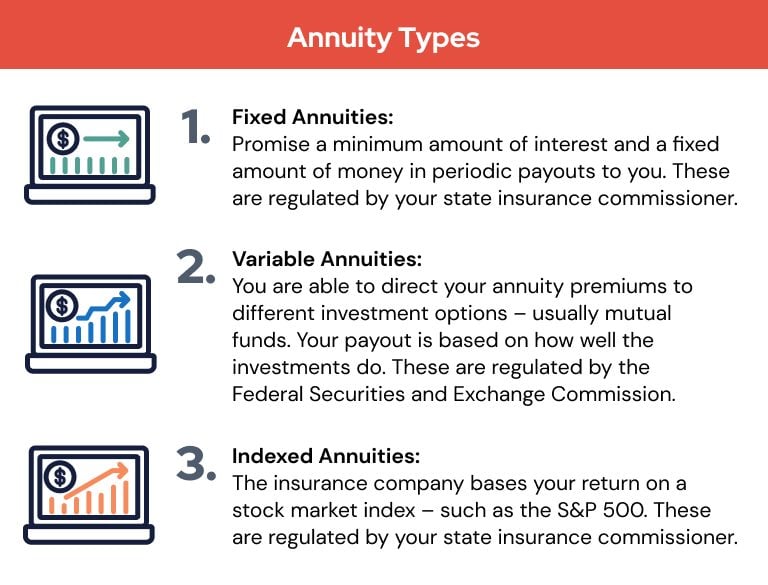All Categories
Featured
Table of Contents
Just as with a taken care of annuity, the proprietor of a variable annuity pays an insurance company a round figure or series of settlements for the guarantee of a collection of future payments in return. As stated over, while a taken care of annuity expands at a guaranteed, consistent rate, a variable annuity expands at a variable price that depends upon the efficiency of the underlying financial investments, called sub-accounts.

Throughout the accumulation stage, properties invested in variable annuity sub-accounts expand on a tax-deferred basis and are exhausted only when the contract proprietor withdraws those revenues from the account. After the accumulation stage comes the income phase. Gradually, variable annuity possessions should in theory increase in value up until the agreement owner determines she or he would certainly like to start taking out cash from the account.
The most considerable problem that variable annuities typically present is high cost. Variable annuities have numerous layers of fees and expenses that can, in aggregate, produce a drag of up to 3-4% of the contract's worth each year.
Highlighting the Key Features of Long-Term Investments A Closer Look at How Retirement Planning Works Defining the Right Financial Strategy Advantages and Disadvantages of Different Retirement Plans Why Choosing the Right Financial Strategy Is Worth Considering How to Compare Different Investment Plans: How It Works Key Differences Between Annuities Fixed Vs Variable Understanding the Rewards of What Is A Variable Annuity Vs A Fixed Annuity Who Should Consider Fixed Annuity Vs Variable Annuity? Tips for Choosing Fixed Index Annuity Vs Variable Annuity FAQs About Fixed Income Annuity Vs Variable Annuity Common Mistakes to Avoid When Choosing Pros And Cons Of Fixed Annuity And Variable Annuity Financial Planning Simplified: Understanding Your Options A Beginner’s Guide to Smart Investment Decisions A Closer Look at Immediate Fixed Annuity Vs Variable Annuity
M&E cost costs are determined as a portion of the agreement worth Annuity providers hand down recordkeeping and other management costs to the contract owner. This can be in the form of a level annual charge or a portion of the contract worth. Management charges may be included as part of the M&E danger cost or might be examined separately.
These fees can vary from 0.1% for passive funds to 1.5% or more for proactively handled funds. Annuity agreements can be personalized in a variety of means to serve the certain demands of the contract proprietor. Some typical variable annuity riders include ensured minimal build-up benefit (GMAB), assured minimum withdrawal benefit (GMWB), and assured minimum income advantage (GMIB).

Variable annuity payments offer no such tax deduction. Variable annuities tend to be very ineffective lorries for passing wide range to the following generation due to the fact that they do not take pleasure in a cost-basis adjustment when the initial agreement proprietor dies. When the owner of a taxable financial investment account dies, the price bases of the investments held in the account are adapted to mirror the market rates of those investments at the time of the owner's death.
Breaking Down Your Investment Choices A Comprehensive Guide to Choosing Between Fixed Annuity And Variable Annuity What Is the Best Retirement Option? Pros and Cons of Various Financial Options Why Choosing the Right Financial Strategy Matters for Retirement Planning Variable Annuity Vs Fixed Indexed Annuity: How It Works Key Differences Between Fixed Annuity Vs Variable Annuity Understanding the Rewards of Long-Term Investments Who Should Consider Strategic Financial Planning? Tips for Choosing the Best Investment Strategy FAQs About Fixed Vs Variable Annuities Common Mistakes to Avoid When Planning Your Retirement Financial Planning Simplified: Understanding Your Options A Beginner’s Guide to Fixed Vs Variable Annuities A Closer Look at Tax Benefits Of Fixed Vs Variable Annuities
As a result, successors can acquire a taxed investment portfolio with a "fresh start" from a tax viewpoint. Such is not the situation with variable annuities. Investments held within a variable annuity do not receive a cost-basis adjustment when the original proprietor of the annuity dies. This indicates that any type of gathered latent gains will be handed down to the annuity proprietor's heirs, in addition to the linked tax obligation burden.
One significant issue connected to variable annuities is the capacity for problems of passion that may feed on the component of annuity salesmen. Unlike an economic consultant, who has a fiduciary duty to make investment choices that profit the client, an insurance policy broker has no such fiduciary responsibility. Annuity sales are very rewarding for the insurance coverage experts that market them due to the fact that of high upfront sales compensations.

Lots of variable annuity agreements include language which places a cap on the portion of gain that can be experienced by specific sub-accounts. These caps protect against the annuity proprietor from completely joining a part of gains that might or else be appreciated in years in which markets generate considerable returns. From an outsider's viewpoint, presumably that financiers are trading a cap on financial investment returns for the previously mentioned assured floor on investment returns.
As noted over, give up costs can drastically limit an annuity proprietor's capability to relocate properties out of an annuity in the very early years of the agreement. Further, while most variable annuities permit agreement proprietors to take out a defined amount during the buildup stage, withdrawals beyond this amount generally result in a company-imposed cost.
Withdrawals made from a fixed rates of interest investment option could additionally experience a "market value adjustment" or MVA. An MVA changes the value of the withdrawal to show any kind of adjustments in rate of interest prices from the time that the cash was purchased the fixed-rate choice to the moment that it was withdrawn.

Frequently, even the salesmen that sell them do not fully comprehend just how they work, therefore salespeople in some cases exploit a customer's emotions to offer variable annuities as opposed to the benefits and viability of the products themselves. We think that financiers ought to fully understand what they possess and just how much they are paying to possess it.
Decoding What Is A Variable Annuity Vs A Fixed Annuity Key Insights on Your Financial Future What Is Variable Annuities Vs Fixed Annuities? Features of Smart Investment Choices Why Choosing the Right Financial Strategy Is a Smart Choice Immediate Fixed Annuity Vs Variable Annuity: Simplified Key Differences Between Fixed Index Annuity Vs Variable Annuity Understanding the Rewards of Choosing Between Fixed Annuity And Variable Annuity Who Should Consider Fixed Index Annuity Vs Variable Annuity? Tips for Choosing the Best Investment Strategy FAQs About Deferred Annuity Vs Variable Annuity Common Mistakes to Avoid When Choosing a Financial Strategy Financial Planning Simplified: Understanding Your Options A Beginner’s Guide to Smart Investment Decisions A Closer Look at How to Build a Retirement Plan
The very same can not be claimed for variable annuity possessions held in fixed-rate investments. These properties legitimately come from the insurance policy business and would certainly as a result be at threat if the business were to fall short. In a similar way, any kind of assurances that the insurance provider has actually consented to offer, such as an ensured minimal revenue advantage, would be in inquiry in the occasion of an organization failing.
Therefore, potential purchasers of variable annuities need to recognize and take into consideration the financial problem of the releasing insurance provider before getting in into an annuity contract. While the advantages and drawbacks of different types of annuities can be questioned, the real problem surrounding annuities is that of suitability. In other words, the concern is: who should have a variable annuity? This concern can be hard to answer, offered the myriad variations available in the variable annuity world, but there are some standard standards that can aid capitalists make a decision whether or not annuities should contribute in their economic plans.
As the saying goes: "Purchaser beware!" This short article is prepared by Pekin Hardy Strauss, Inc. Annuities for retirement income. ("Pekin Hardy," dba Pekin Hardy Strauss Wealth Management) for informational purposes only and is not meant as an offer or solicitation for organization. The information and data in this write-up does not comprise lawful, tax obligation, audit, investment, or various other expert advice
Table of Contents
Latest Posts
Decoding How Investment Plans Work Key Insights on Variable Annuity Vs Fixed Annuity What Is Fixed Income Annuity Vs Variable Annuity? Features of Variable Vs Fixed Annuity Why Variable Vs Fixed Annui
Analyzing Strategic Retirement Planning Key Insights on Your Financial Future Breaking Down the Basics of Investment Plans Features of Annuities Variable Vs Fixed Why Annuities Fixed Vs Variable Matte
Exploring the Basics of Retirement Options Key Insights on Your Financial Future Defining the Right Financial Strategy Pros and Cons of Various Financial Options Why Fixed Income Annuity Vs Variable A
More
Latest Posts